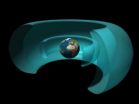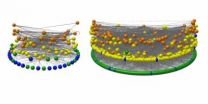Program taught in American Sign Language helps deaf achieve healthier weight
American Heart Association Meeting Report
2014-03-19
(Press-News.org) A group of deaf adults using American Sign Language in a healthy lifestyle program successfully lost weight, according to a study presented at the American Heart Association's Epidemiology & Prevention/Nutrition, Physical Activity & Metabolism Scientific Sessions 2014.
In the first randomized trial of lifestyle modification or weight reduction with deaf people using American Sign Language (ASL), participants had moderate improvements in their weight and level of physical activity after a 16-week program.
"Existing mainstream programs focused on weight and weight-related behaviors are often inaccessible to the deaf community,'' said Steven Barnett, M.D., lead author of the study and associate professor of family medicine and public health sciences at the University of Rochester in New York. "Collaboration with deaf ASL users is essential to develop accessible and culturally appropriate programs."
In partnership with the deaf community in Rochester, the researchers adapted a healthy lifestyle program shown to be effective in hearing people.
A previous study, using accessible public health surveillance in Rochester, found that obesity (body mass index or BMI > 30) is more prevalent in the local deaf community than in the general population – slightly more than 34 percent of the deaf people were obese, compared to nearly 27 percent in the general population.
In the Deaf Weight Wise trial, 104 overweight or obese participants were either enrolled in the healthy lifestyle program, with weekly 2-hour group sessions, or assigned to a delayed group who would receive the intervention later.
For the group sessions, counselors used motivational interviewing techniques to encourage lifestyle change and help participants develop strategies to maintain healthy eating, such as in social situations and during stress. They were encouraged to exercise at least 150 minutes per week.
After six months, participants in the intervention group had lost 7.4 pounds more and reduced their BMI 1.35 points more than the delayed group. Most of the intervention group's participants (58.3 percent) lost at least 5 percent of their baseline weight, compared with 14.3 percent of the delayed group.
Researchers will continue to follow participants for 24 months.
"During program development and during the trial, deaf community members emphasized the importance of having deaf counselors," said Barnett, who directs the Rochester Prevention Research Center: National Center for Deaf Health Research. "I realize this is not possible to implement everywhere at present. We are working on program adaptations to address access to counselors who are deaf ASL users."
Lori DeWindt, M.A., a member of the Deaf Weight Wise Study Group and a Deaf Weight Wise counselor, said, "Participants were comfortable in the culturally affirming environment in which everyone signs. This setting, along with accessible information and peer support, contributed to the positive experience of participants."
INFORMATION:
Co-authors are Erika Sutter, M.P.H., Thomas Pearson, M.D., M.P.H., Ph.D., and members of the Deaf Weight Wise Study Group. Disclosures are listed on the abstract.
The Centers for Disease Control and Prevention Research Centers Program funded the study.
For the latest heart and stroke news, follow us on Twitter: @HeartNews.
Statements and conclusions of study authors that are presented at American Heart Association scientific meetings are solely those of the study authors and do not necessarily reflect association policy or position. The association makes no representation or warranty as to their accuracy or reliability. The association receives funding primarily from individuals; foundations and corporations (including pharmaceutical, device manufacturers and other companies) also make donations and fund specific association programs and events. The association has strict policies to prevent these relationships from influencing the science content. Revenues from pharmaceutical and device corporations are available at http://www.heart.org/corporatefunding.
ELSE PRESS RELEASES FROM THIS DATE:
Spices and herbs intervention helps adults reduce salt intake
2014-03-19
Teaching people how to flavor food with spices and herbs is considerably more effective at lowering salt intake than having them do it on their own, according to research presented at the American Heart Association's Epidemiology & Prevention/Nutrition, Physical Activity & Metabolism Scientific Sessions 2014.
In the first phase of the study, 55 volunteers ate a low-sodium diet for four weeks. Researchers provided all foods and calorie-containing drinks. Salt is the main source of sodium in food.
In the second phase, half of the study volunteers participated in a 20-week ...
US women unfamiliar with most stroke warning signs
2014-03-19
Many U.S. women don't know most of the warning signs of a stroke, according to research presented at the American Heart Association's Epidemiology and Prevention/Nutrition, Physical Activity and Metabolism 2014 Scientific Sessions.
The study is also published in the American Heart Association journal, Stroke.
In a phone survey of 1,205 U.S. women:
More than half (51 percent) of the women identified sudden weakness or numbness on one side of the face, arms or legs as a warning sign of a stroke.
Less than half (44 percent) identified difficulty speaking or garbled speech ...
Researchers identify impaired new learning in persons with Parkinson's disease
2014-03-19
West Orange, NJ. March 20, 2014. Kessler Foundation scientists collaborated with colleagues in Spain to study memory and learning in patients with Parkinson Disease (PD). They found that the Parkinson group's ability to learn new information was significantly poorer when compared with the control group. The article was published ahead of print on February 24: Chiaravalloti ND, Ibarretxe-Bilbao N, Deluca J, Rusu O, Pena J, García-Gorostiaga I, Ojeda N. The source of the memory impairment in Parkinson's disease: Acquisition versus retrieval. Movement Disorders 2014 Feb 24. ...
Analysis: Industry-sponsored academic inventions spur increased innovation
2014-03-19
Industry-sponsored, academic research leads to innovative patents and licenses, says a new analysis led by Brian Wright, University of California, Berkeley professor of agricultural and resource economics.
The finding calls into question assumptions that corporate support skews science toward inventions that are less accessible and less useful to others than those funded by the government or non-profit organizations.
The analysis, based on a study of two decades of records from the University of California system, is in today's science journal Nature.
The National ...
NASA's Van Allen Probes reveal zebra stripes in space
2014-03-19
Scientists have discovered a new, persistent structure in one of two radiation belts surrounding Earth. NASA's twin Van Allen Probes spacecraft have shown that high-energy electrons in the inner radiation belt display a persistent pattern that resembles slanted zebra stripes. Surprisingly, this structure is produced by the slow rotation of Earth, previously considered incapable of affecting the motion of radiation belt particles, which have velocities approaching the speed of light.
Scientists had previously believed that increased solar wind activity was the primary ...
Sometimes less is more for hungry dogs
2014-03-19
Hungry dogs would be expected to choose alternatives leading to more food rather than less food. But just as with humans and monkeys, they sometimes show a "less is more" effect. Thus conclude Kristina Pattison and Thomas Zentall of the University of Kentucky in the US, who tested the principle by feeding baby carrots and string cheese to ten dogs of various breeds. The findings are published in Springer's journal Animal Cognition.
The research was conducted on dogs that would willingly eat cheese and baby carrots when offered, but showed a preference for the cheese. ...
Alzheimer's prevention trial to monitor reactions to higher disease risk status
2014-03-19
PHILADELPHIA - A new clinical trial will soon begin testing whether early medical intervention in people at risk for Alzheimer's can slow down progression of disease pathology before symptoms emerge, as outlined in Science Translational Medicine. For the first time, people with no Alzheimer's disease symptoms will be told of their risk status before being asked to join the randomized controlled trial. As part of the overall prevention trial, Penn Medicine neurodegenerative ethics experts will monitor how learning about their risk of developing Alzheimer's impacts trial ...
NJIT physicist helps to discover a new structure in Earth's radiation belt
2014-03-19
An NJIT physicist is a collaborator in the discovery of a new structure in Earth's inner radiation belt -- a zebra-striped structure of highly energized electrons that could endanger humans in space and also damage low-earth navigation and communication satellites.
And surprisingly, the new structure is produced not by solar activity but by Earth's slow rotation. Scientists had previously thought Earth's rotation couldn't affect the motion of radiation belt particles. The data supporting these discoveries comes from a measuring device aboard the two NASA Van Allen Probes ...
Scientists describe gut bacteria that cause sepsis in preterm infants
2014-03-19
Researchers studying intestinal bacteria in newborns have characterized the gut bacteria of premature infants who go on to develop sepsis, a serious and potentially life-threatening condition caused by bacteria in the bloodstream. Their findings suggest new strategies for the early detection and prevention of severe bloodstream infections. The research was funded by several components of the National Institutes of Health (NIH)—the Eunice Kennedy Shriver National Institute of Child Health and Human Development (NICHD), the National Human Genome Research Institute (NHGRI), ...
Ancient food webs developed modern structure soon after mass extinction
2014-03-19
Researchers from the Santa Fe Institute and the Smithsonian Institution have pieced together a highly detailed picture of feeding relationships among 700 mammal, bird, reptile, fish, insect, and plant species from a 48 million year old lake and forest ecosystem.
Their analysis of fossilized remains from the Messel deposit near Frankfurt, Germany, provides the most compelling evidence to date that ancient food webs were organized much like modern food webs. Their paper describing the research appears online and open access this week in Proceedings of the Royal Society ...
LAST 30 PRESS RELEASES:
Empty-handed neurons might cause neurodegenerative diseases
Black women hospitalised in USA with blood infection resistant to last-resort antibiotic at increased risk of death
NEC Society Statement on the Watson vs. Mead Johnson Verdict
Lemur’s lament: When one vulnerable species stalks another
Surf clams off the coast of Virginia reappear – and rebound
Studying optimization for neuromorphic imaging and digital twins
ORNL researchers win Best Paper award for nickel-based alloy tailoring
New beta-decay measurements in mirror nuclei pin down the weak nuclear force
Study uncovers neural mechanisms underlying foraging behavior in freely moving animals
Gene therapy is halting cancer. Can it work against brain tumors?
New copper-catalyzed C-H activation strategy from Scripps Research
New compound from blessed thistle promotes functional nerve regeneration
Auburn’s McCrary Institute, ORNL to partner on first regional cybersecurity center to protect the nation’s electricity grid
New UNC-Chapel Hill study examines the increased adoption of they/them pronouns
Groundbreaking study reveals potential diagnostic marker for multiple sclerosis years before symptom onset
Annals of Internal Medicine presents breaking scientific news at ACP’s Internal Medicine Meeting 2024
Scientists discover new way to extract cosmological information from galaxy surveys
Shoe technology reduces risk of diabetic foot ulcers
URI-led team finds direct evidence of ‘itinerant breeding’ in East Coast shorebird species
Wayne State researcher aims to improve coding peer review practices
Researchers develop a new way to safely boost immune cells to fight cancer
Compact quantum light processing
Toxic chemicals from microplastics can be absorbed through skin
New research defines specific genomic changes associated with the transmissibility of the monkeypox virus
Registration of biological pest control products exceeds that of agrochemicals in Brazil
How reflecting on gratitude received from family can make you a better leader
Wearable technology assesses surgeons’ posture during surgery
AATS and CRF® partner on New York Valves: The structural heart summit
Postpartum breast cancer and survival in women with germline BRCA pathogenic variants
Self-administered acupressure for probable knee osteoarthritis in middle-aged and older adults
[Press-News.org] Program taught in American Sign Language helps deaf achieve healthier weightAmerican Heart Association Meeting Report


